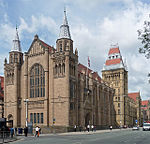
The University of Manchester Institute of Science and Technology (UMIST) was a university based in the centre of the city of Manchester in England. It specialised in technical and scientific subjects and was a major centre for research. On 1 October 2004, it amalgamated with the Victoria University of Manchester to produce a new entity called the University of Manchester.

Illinois Institute of Technology (IIT) is a private research university in Chicago, Illinois. Tracing its history to 1890, the present name was adopted upon the merger of the Armour Institute and Lewis Institute in 1940. The university has programs in architecture, business, communications, design, engineering, industrial technology, information technology, law, psychology, and science. It is classified among "R2: Doctoral Universities – High research activity".

The Victoria University of Manchester, usually referred to as simply the University of Manchester, was a university in Manchester, England. It was founded in 1851 as Owens College. In 1880, the college joined the federal Victoria University. After the demerger of the Victoria University, it gained an independent university charter in 1904 as the Victoria University of Manchester.

The University of Manchester is a public research university in Manchester, England. The main campus is south of Manchester City Centre on Oxford Road. The university owns and operates major cultural assets such as the Manchester Museum, The Whitworth art gallery, the John Rylands Library, the Tabley House Collection and the Jodrell Bank Observatory – a UNESCO World Heritage Site.

Sir Denys Louis Lasdun, CH, CBE, RA was an eminent English architect, the son of Nathan Lasdun (1879–1920) and Julie. Probably his best known work is the Royal National Theatre, on London's South Bank of the Thames, which is a Grade II* listed building and one of the most notable examples of Brutalist design in the United Kingdom.
Brutalist architecture is an architectural style that emerged during the 1950s in the United Kingdom, among the reconstruction projects of the post-war era. Brutalist buildings are characterised by minimalist constructions that showcase the bare building materials and structural elements over decorative design. The style commonly makes use of exposed, unpainted concrete or brick, angular geometric shapes and a predominantly monochrome colour palette; other materials, such as steel, timber, and glass, are also featured.
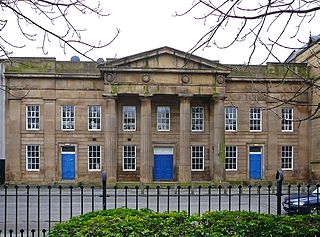
Chorlton-on-Medlock or Chorlton-upon-Medlock is an inner city area of Manchester, England.
The University of Manchester Students' Union is the representative body of students at the University of Manchester, England, and is the UK's largest students' union. It was formed out of the merger between UMIST Students' Association (USA) and University of Manchester Union (UMU) when the parent organisations merged on 1 October 2004.

Rudolph Hall is one of the earliest and best-known examples of Brutalist architecture in the United States. Completed in 1963 in New Haven, Connecticut, the building houses Yale University's School of Architecture. Until 2000, it also housed the School of Art.

Bradshaw Gass & Hope is an English architectural practice founded in 1862 by Jonas James Bradshaw. The style "Bradshaw Gass & Hope" was adopted after his death referring to the remaining partners John Bradshaw Gass and Arthur John Hope.

The Sciences Library, nicknamed the "SciLi", at Brown University is a high-rise building in Providence, Rhode Island built in 1971 in the Brutalist style. At 180 feet (55 m), it is tied with One Citizens Plaza as the 16th-tallest building in the city. The building houses Brown University's primary on-campus collections that support study and research in the fields of Medicine, Psychology, Neural Science, Environmental Science, Biology, Chemistry, Geology, Physics, Engineering, Computer Science, and Pure and Applied Mathematics. SciLi is also the home of the Science Center, the Writing Center, the Center for Language Studies, the Map Collection, the Interlibrary Loan office, and the Friedman Study Center. SciLi is one of five on-campus libraries which make up the University Library.

The Renold Building is a university building in Manchester. It was opened on 23 November 1962 for the Manchester College of Science and Technology as part of a major expansion of its campus in the 1960s. The architect was W.A.Gibbon of the firm of Cruickshank and Seward. The foundation stone was laid on 24 June 1960 by Sir Charles Renold J.P. LL.D (1883–1967), Vice President of the college, and chairman of the planning and development committee, after whom it was named. The main contractor was J. Gerrard & Sons Ltd of Swinton.
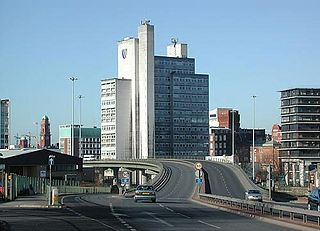
The Maths and Social Sciences Building is a high-rise tower in Manchester, England. It was part of the University of Manchester Institute of Science and Technology (UMIST) until that university merged with the Victoria University of Manchester, to form the University of Manchester, in 2004. It was vacated by the university in 2010 but is currently in use by the School of Materials while waiting for a new building to be constructed.

The Alan Turing Building, named after the mathematician and founder of computer science Alan Turing, is a building at the University of Manchester, in Manchester, England. It houses the School of Mathematics, the Photon Science Institute and the Jodrell Bank Centre for Astrophysics. The building is located in the Chorlton-on-Medlock district of Manchester, on Upper Brook Street, and is adjacent to University Place and the Henry Royce Institute. While under construction the project was known as AMPPS : Astronomy, Mathematics, Physics and Photon Science. The building was shortlisted for the Greater Manchester Building of the Year 2008 prize, which is awarded by the Greater Manchester Chamber of Commerce. The manager of the building project was awarded a silver medal in the Chartered Institute of Building "Construction Manager of the Year" awards.
The University of Nottingham operates from four campuses in Nottinghamshire and from two overseas campuses, one in Ningbo, China and the other in Semenyih, Malaysia. The Ningbo campus was officially opened on 23 February 2005 by the then British Deputy Prime Minister, John Prescott, in the presence of Chinese education minister Zhou Ji and State Counsellor Chen Zhili. The Malaysia campus was the first purpose-built UK university campus in a foreign country and was officially opened by Najib Tun Razak on 26 September 2005. Najib Tun Razak, as well as being a Nottingham alumnus, was Deputy Prime Minister of Malaysia at the time and has since become Prime Minister of Malaysia.
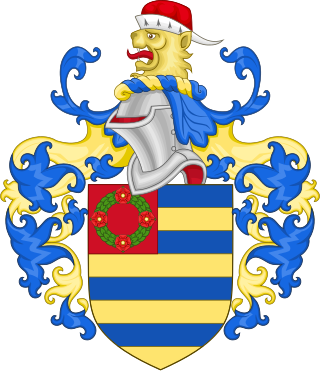
Hulme Hall is a University of Manchester hall of residence situated at the Victoria Park Campus in Rusholme, Manchester, housing 300 students. It has a range of facilities including the John Hartshorne Centre: a 300 seat lecture theatre with attached seminar rooms; a library; Junior Common Room and study spaces; music room; old dining hall; the Victoria Park bar; and chapel. Local student attractions include the Whitworth Art Gallery and the Curry Mile on Wilmslow Road.

The Sackville Street Building is a building on Sackville Street, Manchester, England. The University of Manchester occupies the building which, before the merger with UMIST in 2004, was UMIST's "Main Building". Construction of the building for the Manchester School of Technology began in 1895 on a site formerly occupied by Sir Joseph Whitworth's engineering works; it was opened in 1902 by the then Prime Minister, Arthur Balfour. The School of Technology became the Manchester Municipal College of Technology in 1918.
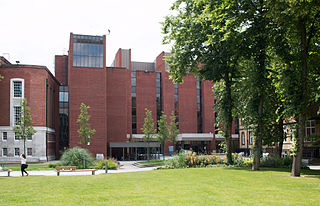
The University of Manchester Library is the library system and information service of the University of Manchester. The main library is on the Oxford Road campus of the university, with its entrance on Burlington Street. There are also ten other library sites, eight spread out across the university's campus, plus The John Rylands Library on Deansgate and the Ahmed Iqbal Ullah Race Relations Resource Centre situated inside Manchester Central Library.

Kingston University London is a public research university located within the Royal Borough of Kingston upon Thames, in South West London, England. Its roots go back to the Kingston Technical Institute, founded in 1899. It received university status in 1992, before which the institution was known as Kingston Polytechnic.

The architecture of Jacksonville is a combination of historic and modern styles reflecting the city's early position as a regional center of business. According to the National Trust for Historic Preservation, there are more buildings built before 1967 in Jacksonville than any other city in Florida, but it is also important to note that few structures in the city center predate the Great Fire of 1901. Numerous buildings in the city have held state height records, dating as far back as 1902, and last holding a record in 1981.



















